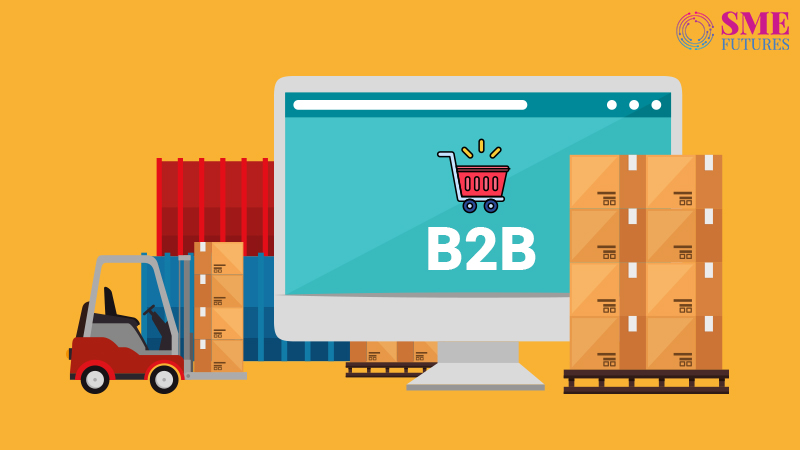E-commerce has transformed the way buying and selling of products is done in India, and much of the growth has been led by increasing penetration of smartphones and cheaper internet. And, business-to-consumer (B2C) companies managed to overshadow the market for long, both in terms of gaining popularity and investors’ attention. But the times have changed.
Today, B2B commerce companies are the ones taking the market by storm. At a time when companies like Flipkart and Amazon are still burning money, the B2B space – this year – witnessed the biggest success story in the form of Indiamart successful IPO (initial public offering); in addition to another B2B company Udaan hitting unicorn status within just two years of its operations.
Seven companies in the e-commerce sector reached unicorn status in 2018, proving investor confidence and willingness to back innovative products and services, according to EY report, E-commerce and Consumer Internet Sector – India Trend Book 2019. While B2C e-commerce grabbed all the limelight, B2B continued to grow silently. “The potential of B2B is in fact reflective in the B2C only being three per cent of the retail spend; and that too organized retail is only 12-15 per cent of the total retail spend. It is no surprise then that B2B is globally 2x of B2C, and India is following a similar trajectory,” the report added.
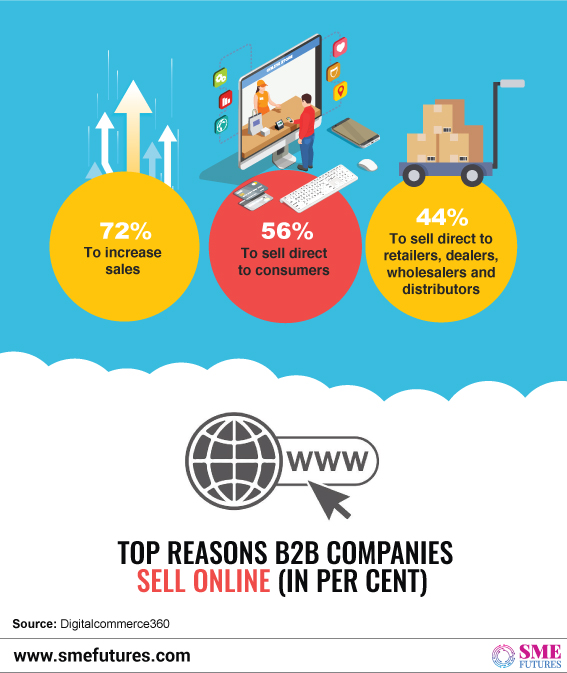
Digitalization
With over 430 million internet users, India is the second largest online market, ranked only behind China. Internet users in India are expected to increase to about 635.8 million by 2021, according to an EY report Despite the big base of internet users, India continues to lag peer countries.. However, steps like demonetization, goods and services tax (GST) and digital governance continue to act as tailwinds, encouraging the development and adoption of the digital economy framework. Though the back-to-back reforms turned out to be a road bump for a while for the business community – resulting into a tumbling economy. But, these policies came as a boon for the booming industry of e-commerce – particularly B2B e-commerce.
Ease of doing business with digital transactions provided for a massive opportunity for growth and expansion for e-commerce and consumer internet companies. No FDI (foreign direct investments) restrictions for the B2B sector makes it more lucrative for the opportunists. With this, the overall e-commerce sector is expected to reach US$ 200 billion by 2027, and is expected to be a significant avenue to offer jobs and building micro-entrepreneurship in the country.
On the other hand, B2B companies have been carving a niche for themselves. The B2C segment is primarily driven by consumer durables, apparels, home furnishings, and FMCG products; while the B2B companies add significant value to the supply chain – using technology – especially in tier II and tier III cities where access to products, inventory holdings and pricing is always a challenge. Industrial supplies and construction materials is another segment where some of the B2B players are focused on. All this digitalization improves serviceability, stickiness and personalization, ultimately improving earnings and working capital for retailers.
VC money pouring into B2B e-commerce
Sensing the opportunity, investors are also queuing up for deals in this segment. Out of over US$ 7 billion raised by the e-commerce and consumer internet companies in 2018, B2B’s share stood at US$ 540 million – that is 7.3 per cent of the total investments. Prior to 2018, the B2B segment had recorded “limited” deal activity with the largest deal in the five years preceding 2018 being of US$ 36 million.
However, in 2019 B2B e-commerce gained more funding momentum with companies such as Udaan raising a whopping US$ 585 million at US$ 2.8 billion valuation. B2B marketplace for industrial goods Moglix and B2B agri-tech firm NinjaCart raised US$ 60 million and US$ 89.5 million respectively from marquee investor Tiger Global. And, the 20-year old B2B listing company Indiamart surprised the Indian internet ecosystem with its successful stock listing in July this year. The company is valued at about US$ 800 million at its current share price.
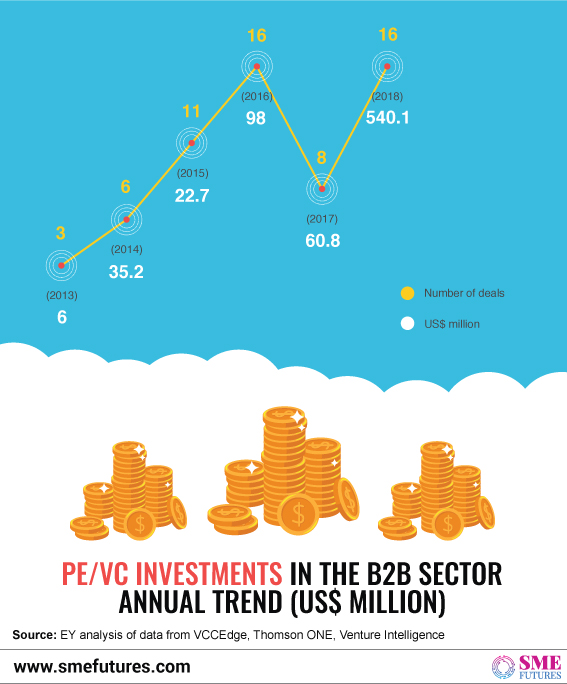
Power2SME, ShopX, IndustryBuying, TradeIndia, Excess2sell, B2BAdda . SAIL and Tata Steel-promoted steel and coal marketplace Mjunction, and textile-focused marketplace Texfy are some of other startups in the segment. In fact, the e-commerce behemoth also jumped into the B2B bandwagon in 2017 with ‘Amazon Business’ – seeing the massive growth opportunity.
“India’s B2B business base is 50 million-strong, and while it is a direct supplier of goods to the country’s 14 million retailer base, its reach remains stunted. E-tailing in India grew rapidly to become a US$ 525 billion industry because it enjoys the advantage of being in the B2C marketplace. But the B2B e-commerce market is yet to realize its full potential and what it needs right now is a solution-based tech intervention,”
says Rajan Sharma, founder and CEO, Excess2Sell.com.
B2B propellers
With all the connected multiple touch points, e-commerce is no longer nebulous for B2B – but a driving force. Merchants are taking advantage of digital channels while moving away from the mentality of digital is simply a commercial order entry channel. Instead, they are implementing omni-channel, end-to-end customer experiences, combining branches, distributors, salespeople and contact centers seamlessly with the web.
Mobile devices are playing big part in propelling the B2B marketplace. A Forrester research notes that with everything available on the online channels, at least 74 per cent buyers do half of the research online, before making an offline purchase from vendors. While, around 42 per cent of these researches are done via mobile devices, says another study done by Google.
B2B organizations are shifting their salesforce to become more solutions-focused, detailed and consultative. And they are investing heavily in technology and services that allow the salesperson to do that.
App-based solutions such as artificial intelligence (AI), analytics, machine learning algorithm are further facilitating the services, marketing, traffic on these websites; and provide ways to improve e-marketplaces.
“Artificial intelligence is being tested and applied in new ways. About 79 per cent companies use chatbots for customer service use-case and 32 per cent also use it in the payment process. Similarly, 73 per cent of companies use augmented reality (AR) and virtual reality (VR) for customer service applications, and 66 per cent also use them in the sales process,” an Accenture report adds.
B2B leaders are doubling down on their investments for new technologies. By prioritizing tech, they can capture a holistic view of the customer, use data to create insights that address specific customer problems, and create tailored solutions that salespeople can then take to the customer.
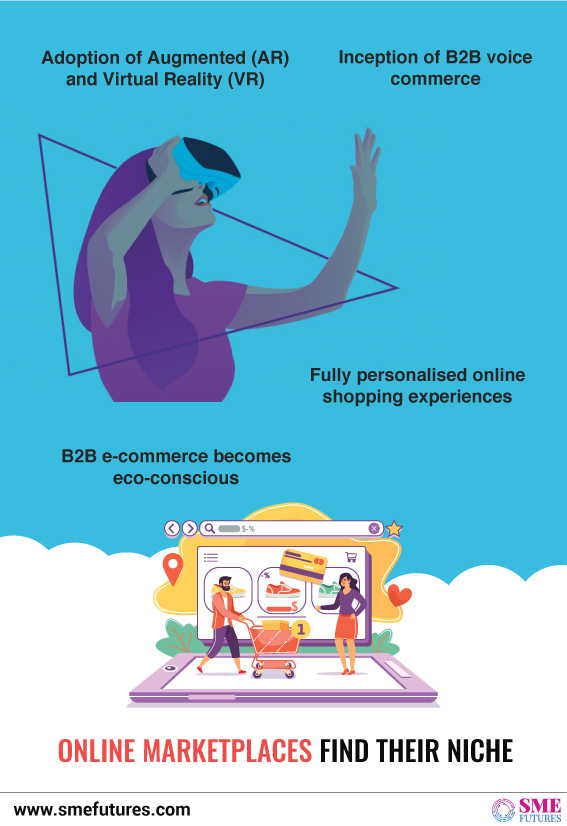
What lies ahead
Initially, B2B have focused on the digital supply chain, onboarding retailers and changing buying behaviour, but the future will be driven by enhanced logistics efficiency, information-driven demand generation, improved capital cycles, and therefore, shorter consumption cycles.
Companies will have to improve their distributed logistics and support larger product catalogues and discovery in order to grow. In the future, there may be opportunities for them to introduce private-label products to feed the existing supply chain, apart from also looking at direct manufacturing partnership opportunities for further improving unit economics and assortments.
Another opportunity for B2B players will be leveraging their networks to support their non-rival B2C companies. Ultimately, as the ecosystem builds, B2B users will become comfortable to transact on B2C sites as well, resulting into data-driven tie-ups between B2B and B2C companies.
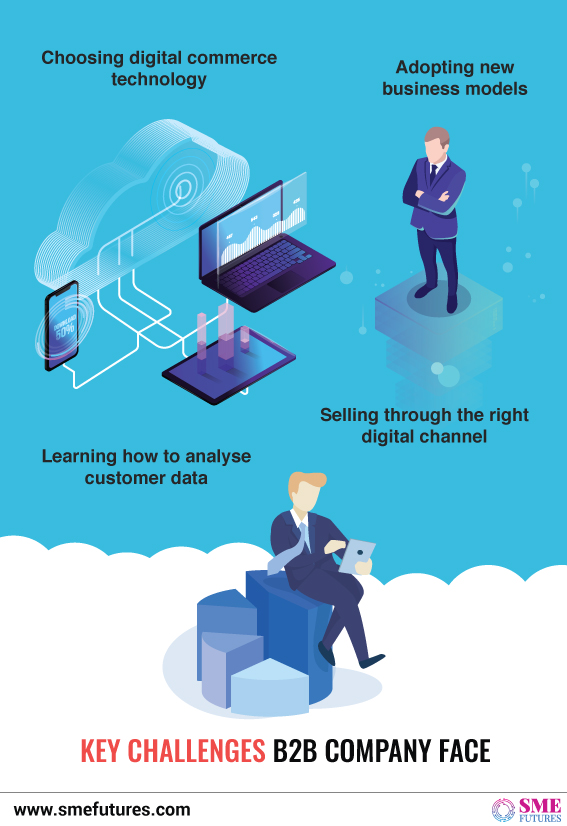
Omni-channel in B2B is also a reality given the multiple segments it can operate into. .. Supply chain financing and credit financing are fast catching the attention of these companies, and Udaan is the biggest example.. This is likely to help these companies build larger ‘profitable’ businesses as the SME credit market is still largely untapped. Building on top of this, there could be other avenues of revenues to feed the supply chain pipe with offering, including insurance, health services, digital payments etc – making the full stack model a compelling opportunity for B2B.
“It’s imperative for brands to build real-time connect with the end-customers in order to make a place in their life. We strive hard to make each and every brand associated with us to build desired brand-equity by significantly expanding sales, reach and brand footprint with the most effective sales channel.”
shares B2BAdda.com founder Yogesh Bhatia
By 2020, digital customer experience and digital sales channels will become primary points of differentiation for B2B companies. Brands that adapt to the changing expectations and behaviour stand to benefit, while those that ignore the trend will risk losing significant market share and see their businesses disrupted.
The B2B e-commerce sector, few years back, had its own share of failures that include few shutdowns – Shotang, Tolexo, Buildzar etc, but after tremendous changes over past few years, it has come of age. May be five years ago, B2B would not have been an ideal space to be in [since all the venture capital money were put into the consumer internet companies], but looks like ‘now’ is the right time to be in this business.

